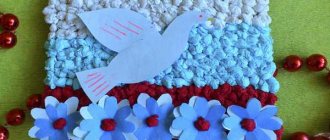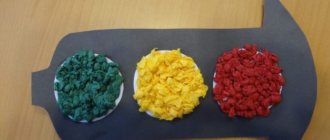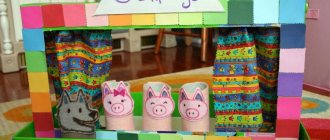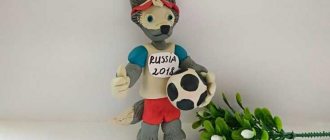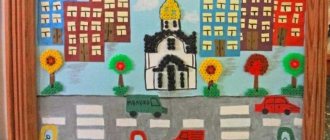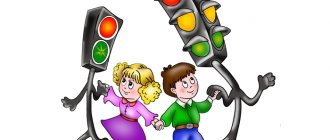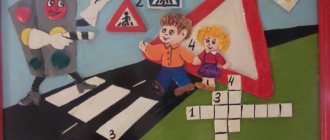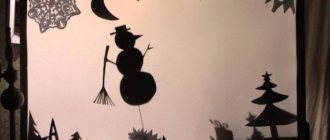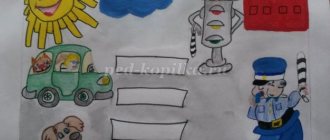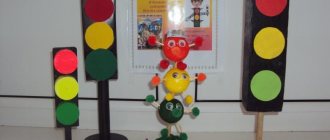The game process is recognized by modern teachers as a very effective way of providing children with the necessary information. Working together with them turns classes into an exciting process.
We offer several techniques for making crafts on the topic of traffic rules in a kindergarten with their own hands to instill a culture of safe movement on the street. In addition to road signs, children can make a mini-city filled with car models and traffic lights.
Simple ways to make a traffic light
In older preschool age, you can safely make crafts using electrical parts. A very original option is a traffic light made from plastic bottles. 2-liter dark bottles will do. Three windows are cut into them with scissors or a cutter. Each of them contains light bulbs connected by batteries and equipped with power buttons.
To install a traffic light near an intersection, mount it on a portable PVC pipe. Cover the windows with colored glass or film. Bring the control device into operation by pressing the desired button.
Fabric craft
This version of the traffic light is more suitable for girls and real needlewomen. A sewn fake can also serve as an educational toy if the circles are made with Velcro.
So, let's begin:
- You need to take rectangular pieces of black fabric and lay a small layer of foam rubber between them. Sew it together.
- Next, cut out circles from felt (red, yellow, green). We sew them along the edges. You need to sew one part of the Velcro to the traffic light body itself, and the second part directly to the circles.
- For a more interesting design, you can make a fabric lid on top. Having previously divided it into three parts. Thus, each color will be opened separately, or all at once. The fabric craft is ready.
Making a paper traffic light
A very simple but interesting craft made using the appliqué technique. The shape of the traffic light is created from black cardboard. Three white circles are glued to one side. Colored signals in the form of dog faces will be created from red, yellow and green paper.
Cut out a square of paper and fold it diagonally. Fold in half again. Bend the upper corners of the resulting triangle down so that the ears are drawn. They can be long or short. For each muzzle, cut out circles for eyes from white paper.
Draw eyebrows and smiles according to the color of the traffic light. Red, yellow or green smiles should be appropriate.
Instead of cardboard, you can use packaging made from natural juice or milk, covering it with black paper.
Traffic light from a plastic bottle
This fabulous option is very easy. Let's turn on our imagination. We will need:
- Plastic bottle
- Brushes and paints (preferably gouache)
- Colored paper
- PVA glue
- Scissors
Work progress:
- We choose a plastic bottle, it is better to take the one with a longer neck.
- We paint it a neutral color (meaning not red, not yellow, not green). Let it dry.
- Next, we cut out circles from colored paper for the traffic light itself and details for our fairy-tale character. These are eyes, mouth, nose, ears, hands.
- The bottle is dry. Carefully glue the finished parts and, of course, the circles, making sure that the distance between them is the same.
- But our hero cannot be without hair! We also make hair from paper. Cut into thin strips and twist with scissors.
- We also make the cap out of paper. And look what happened. To fully complete our hero, we will add a rod or a road sign to the handles.
We create a mini-city for studying traffic rules
The layout has a complex design. It will turn out large and voluminous, but its creation will require few materials. This craft on the topic of traffic rules will be a good teaching material. The mini-city is made from cardboard and colored paper using watercolor paints, brushes, scissors and glue.
Technique for making a city model
- Prepare cardboard boxes of different sizes. Cover them with colored paper and decorate them with windows cut out of plain white paper.
- Cut off the top of a large box and decorate its bottom according to the plan of the future city.
- If the project includes a river, paint it blue or cyan.
- Paint the road black and apply white markings.
- Cut out circles from cardboard and draw traffic signs on them. To install next to the road, glue it to a wire stand.
- A traffic light is created from a cardboard rectangle onto which colored circles are glued: red, yellow and green.
- You can stretch a wire across the road to serve as a wire for suspended traffic lights. Its ends are glued on top of the houses.
- Make trees, shrubs and flowers from plasticine. Create additional elements: benches in the courtyards, a bridge across the river, a fountain.
This craft will help you not only learn safety rules, but also colors. To make the layout more realistic, use Lego figures and toy car models.
Public or specialized transport can be created from matchboxes with colored paper glued to them. Instead of headlights, small buttons are glued to the boxes.
City layout for the game
Instead of a big city, you can create a small structure for playing traffic rules, which is suitable for preschool children:
- Cut a playing field out of a large cardboard box, place houses and signs on it, and crosswalks across the road.
- Come up with an interesting task for the pedestrian.
- You can use Kinder figures as characters.
- Cut and glue the game cube, placing the required number of dots from one to six on each side.
Have a nice trip and enjoy your time!
A game
To test your knowledge of traffic rules, you can create a portable game.
- We create a playing field with houses, signs and pedestrian crossings.
- We are thinking through interesting tasks that a pedestrian who finds himself at one point or another in the game will need to do.
- We select pedestrian characters of the game.
- Cut and glue the cube for the game. If you still have the old one, even better.
Now let's go!
Wall newspaper
The wall newspaper helps to consolidate the acquired knowledge and will serve as an excellent craft on the topic of road safety. For young intellectuals, it can be designed as a crossword puzzle or a tea puzzle. It can be filled with information about traffic rules competitions or the intricacies of the work of a guard at an intersection.
Master class on making wall newspapers
- Take whatman paper in A1 format and measure its length and width.
- Prepare the plywood and cut it to size, then mount it to the wall.
- On whatman paper, mark places for the main heading, thematic sections and articles.
- Fill the wall newspaper with the necessary material using paints, brushes, markers and pencils.
- Take the buttons and attach the wall newspaper to the plywood.
Our didactic material on the topic of road safety is ready. Teaching staff can be offered to hold a competition to create wall newspapers between school classes. A stand with a colorfully decorated wall newspaper is perfect for a themed event.
Explanation of traffic rules in kindergarten through crafts
The child, creating crafts and playing with them, has fun getting acquainted with traffic rules. Play is a basic activity for preschoolers. Through it, the children learn about the environment. Bright layouts are created independently or in groups, quietly studying and consolidating knowledge of traffic rules:
- names of parts of the street, their purpose;
- traffic light color function;
- road markings and their meanings;
- correct behavior as a driver, passenger, pedestrian;
- traffic controller function;
- road signs.
Fun activity
The tasks become more complicated from the younger to the older groups of the garden. Junior groups create simple appliqués from geometric blanks cut out by the teacher. The essence of the technique: leaves of the appropriate shape and color are carefully glued into the drawn figures. For example, multi-colored circles are glued to the right places on an image of a traffic light.
Children from the middle groups of preschool educational institutions cut out simple silhouettes on their own according to the teacher’s template, select the material to their liking (natural, purchased, waste), and follow the step-by-step instructions. At this age, more complex appliqué techniques are used: cut-off, modular. Scrap crafts are images filled with scraps of colored paper of different sizes.
The finished application resembles a mosaic. First, they draw a base image, which will be filled with pieces of material. Tear or cut the paper with their own hands (kids do this with their fingers, without using dangerous tools).
The modular application for traffic rules is often used in the older group. The essence of the method: parts are folded out of paper and assembled into one figure. This is how they create traffic lights with flowers, pedestrians, and cars.
Note! The middle group works according to instructions, under the supervision of the teacher.
Students from 4 years old can prepare elements of three-dimensional construction sets from available materials and assemble them. The figures created by the group are placed in the form of a game layout: streets with roads, houses, traffic lights, cars. For example, a traffic controller or a traffic light is made from several boxes covered with colored sheets of paper. The teacher and parents can help the baby.
Preschoolers aged 6-7 years rarely use instructions. The guys show their imagination and select the most suitable material. They implement the idea using previously acquired skills in drawing, modeling from plasticine, appliqué, and design.
The goals of creating crafts for kindergarten on the topic “Road Rules”:
- formation of knowledge of traffic rules;
- improving fine motor skills;
- fostering independence and accuracy;
- enrichment of the dictionary with traffic rules terms;
- development of imaginative thinking.
These goals can be achieved through creative work.
Road signs for games in the yard
You will need to take white plastic and cut it into the shape of a road sign: round, square or triangular. It is advisable to find an image of the sign on the Internet and print it out. After this, the picture should be transferred to self-adhesive paper, from which a stencil will be created.
Cut out areas that require painting. Glue the rest of the part onto the plastic. Paint the cut out areas with acrylic paint, forming central elements from it. Let the paint dry completely, then remove the stencil.
To disguise the plastic cut, attach a plastic profile to the edges of the sign. It will form a neat white border.
Secure the workpiece to a wooden strip with a cross fixed at the bottom.
Intersection model
The main task facing teachers, parents and educators in teaching traffic rules is to create the skill of safe behavior in the road infrastructure. To do this, we use crafts on the topic “Transition”. This is a traffic light, a pedestrian crossing and a themed road sign.
You can make a model of an intersection on the territory of a school, yard or kindergarten. We are looking for a flat, straight surface (so that water does not accumulate in puddles there). Using a tape measure and chalk, we mark the places where traffic lights are installed and where the pedestrian crossing intersects with the improvised roadway. Using a meter and chalk we draw a pedestrian crossing. Then, using acrylic paint, we draw curbs and a pedestrian crossing from top to bottom. We remember that there should be a traffic light at each corner of the intersection.
Photo ideas on the topic of traffic rules
The photo of the crafts shows other interesting ideas on the topic of traffic. There are options made entirely from plasticine or textiles. The photographs show different ideas made from plastic and other materials. For example, a children's backpack can be decorated with a decorative element in the form of a traffic light woven from beads.
Miniature city
A small city can even be assembled in the lid of a cardboard box. This composition includes several roads and sidewalks, houses, a school or kindergarten, and shops. It is imperative to create intersections and pedestrian crossings.
Master class on creating one of the districts of the mini-city:
- A diagram of the neighborhood is drawn up on the lid of the box. The basis is 2 wide roads intersecting in the center of the composition.
- The roads are formed from wide strips of black paper in the shape of a cross. Narrow black stripes are fixed parallel to them - sidewalks.
- Three-dimensional houses are made from paper. Windows, doors, decor, and signs are glued to them. The most important facilities for the child are highlighted: kindergarten, school, store, playrooms, etc. The houses are fixed to the bottom of the box, forming neighborhoods.
- Trees are made from twigs, toothpicks and plasticine and installed along the street and in courtyards.
- It is advisable to allocate one of the areas for a park. Here you need to install trees, glue the surface of a small lake, and make attractions out of paper.
- The road is being marked. A dividing strip is made from a thin white strip in the center. Near the intersection, “pedestrian zebras” are marked with small white stripes.
- Crosswalks and intersections are equipped with traffic lights and the necessary road signs.
- Cars are made from plasticine or paper. You can use small toy cars.
You can make several such crafts. They are put together to create a town. The roads must be connected to ensure the “passage” of cars throughout the mini-city.
